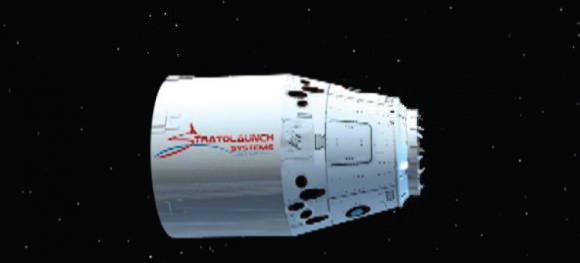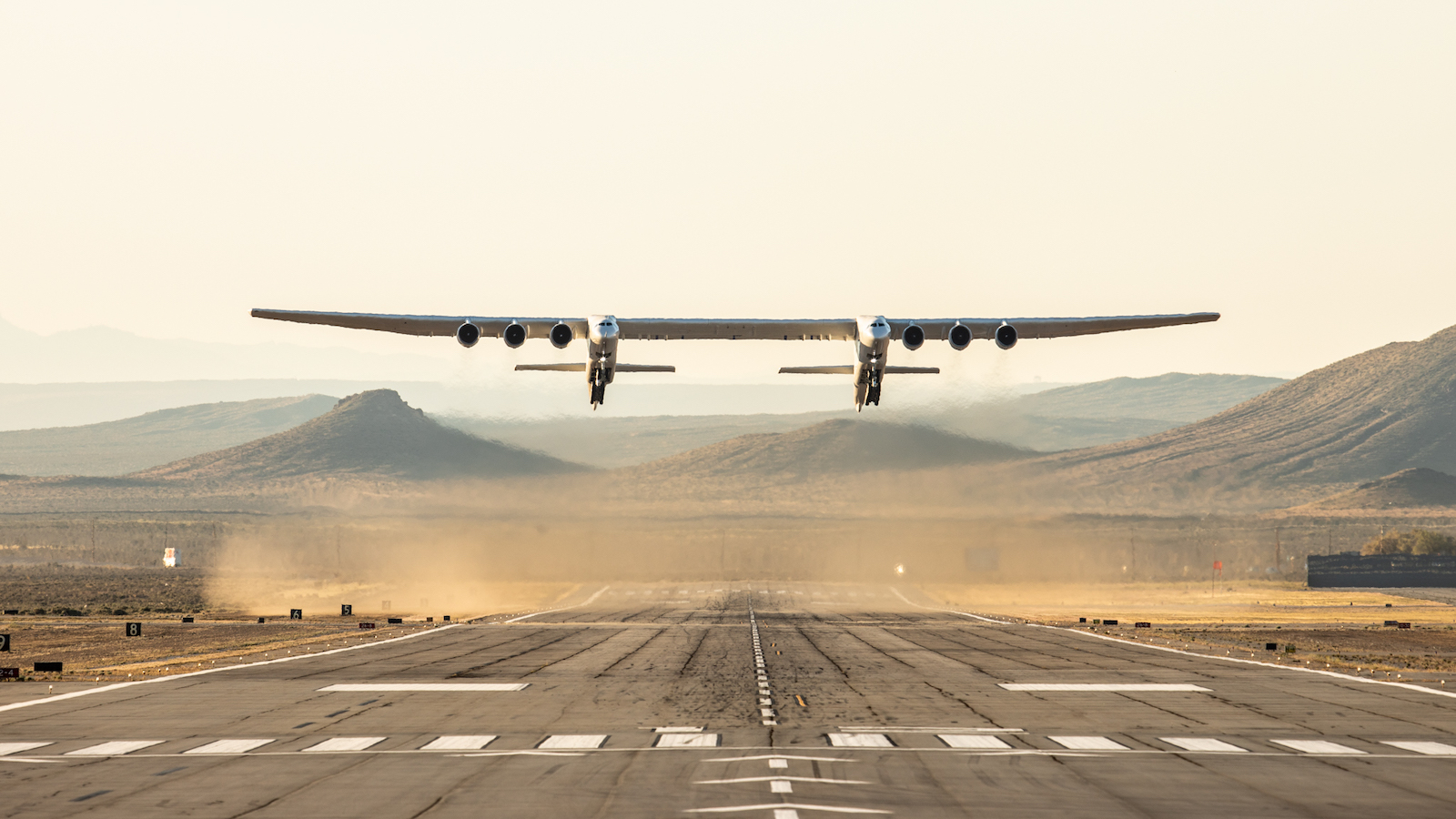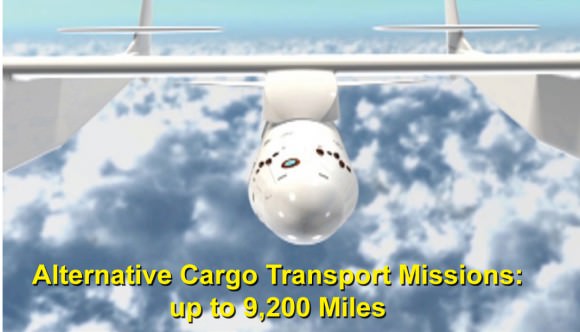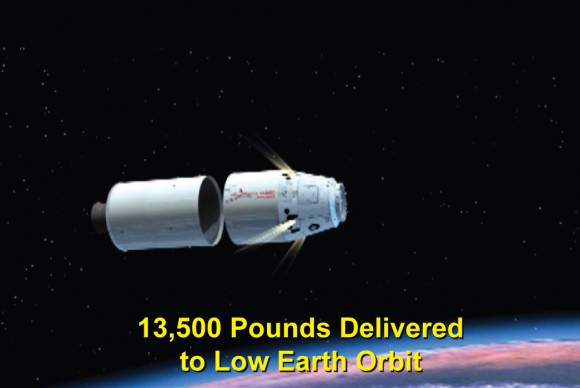A year ago, the high-altitude launch company Stratolaunch flew the world’s largest aircraft. Now, Stratolaunch has revealed the designs of two hypersonic aircraft plus a reusable space plane that will be launched from its giant Carrier Aircraft launch plane. The company hopes to begin test flights of these vehicles by 2022.
Continue reading “Stratolaunch Shows Off its New Hypersonic Testing Vehicle”The World’s Biggest Aircraft – the Rocket-Launching Stratolaunch – Completes its First Test Flight
In 2011, Microsoft co-founder Paul G. Allen and Scaled Composites founder Burt Rutan announced the creation of Stratolaunch Systems. With the goal of reducing the associated costs of space launches, the company set out to create the world’s largest air-launch-to-orbit system. After many years, these efforts bore fruit with the unveiling of the massive Scaled Composites Model 351 Stratolaunch air carrier in the Summer of 2017.
Similar in principle to Virgin Galactic’s SpaceShipTwo, this behemoth is designed to deploy rockets from high altitudes so they can send payloads to Low-Earth Orbit (LEO). After multiple tests involving engine preburns and taxiing on the runway, the aircraft made its inaugural flight last weekend (Saturday, April 13th) and flew for two and half hours before safely landing again in the Mojave Desert.
Continue reading “The World’s Biggest Aircraft – the Rocket-Launching Stratolaunch – Completes its First Test Flight”The Biggest Airplane Taxis Down the Runway, By 2020 it Could Be Launching Rockets
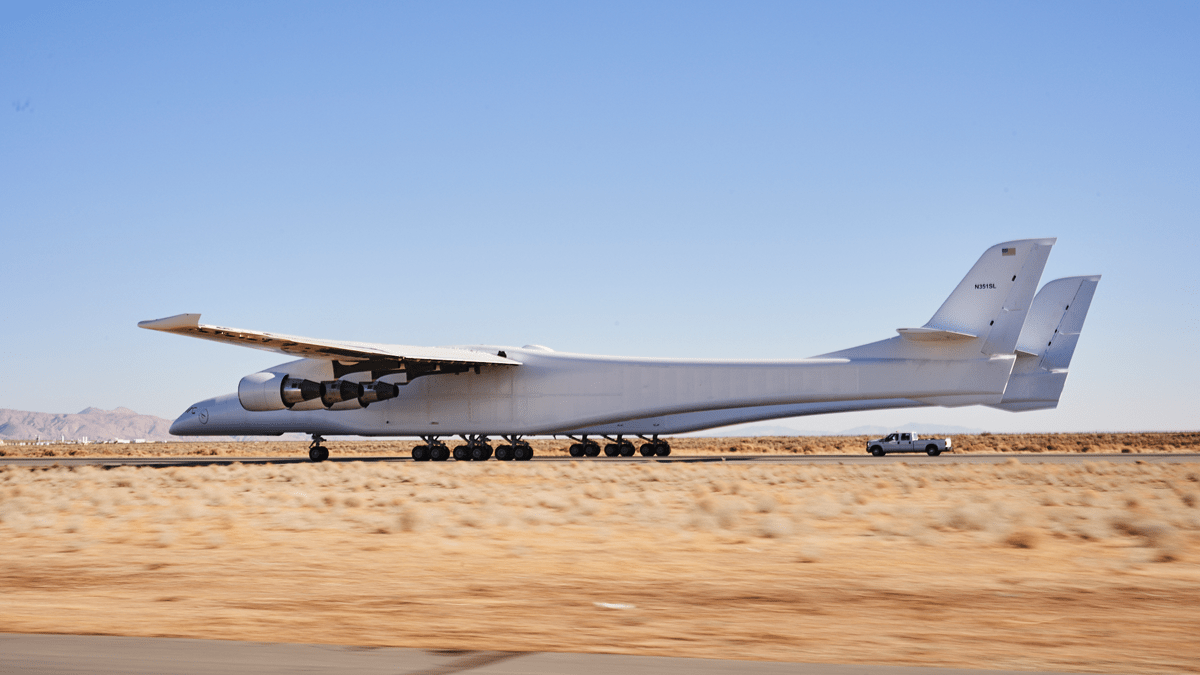
In 2011, Stratolaunch Systems was founded with a simple goal: to reduce the costs of rocket launches by creating the world’s largest air-launch-to-orbit system. Similar to Virgin Galactic’s SpaceShipTwo, this concept involves a large air carrier – Scaled Composites Model 351 (aka. the “Roc”) – deploying rockets from high altitudes so they can deliver small payloads to Low-Earth Orbit (LEO).
Recently, the aircraft reached a major milestone when it conducted its second taxi test at the Mojave Air and Space Port. The test consisted of the aircraft rolling down the runway at a speed of 74 km/h (46 mph) in preparation for its maiden flight. The event was captured on video and posted to twitter by Stratolaunch Systems (and Microsoft) co-founder Paul Allen, who was on hand for the event.
The Roc is essentially two 747 hulls mated together, making it the largest aircraft in the world – spanning 117 meters (385 ft) from one wingtip to the other and weighing 226,796 kg (500,000 lbs). It is powered by six Pratt & Whitney turbofan engines, giving it a maximum lift capacity of up to 249,476 kg (550,000 pounds). This would allow it to air-launch rockets that could deploy satellites to Low-Earth Orbit (LEO).
Captured new video of @Stratolaunch plane as it reached a top taxi speed of 40 knots (46 mph) with all flight surfaces in place on Sunday. The team verified control responses, building on the first taxi tests conducted in December. pic.twitter.com/OcH1ZkxZRA
— Paul Allen (@PaulGAllen) February 26, 2018
As with other alternatives to rocket launches, the concept of an air-launch-to-orbit system is a time-honored one. During the early days of the Space Race, NASA relied on heavy aircraft to bring experimental aircraft to high altitudes (like the Bell X-1) where they would then be deployed. Since that time, NASA has partnered with companies like Orbital ATK and the Virgin Group to develop such a system to launch rockets.
However, the process is still somewhat limited when it comes to what kinds of payloads can be deployed. For instance, Orbital ATK’s three-stage Pegasus rocket is capable of deploying only small satellites weighing up to 454 kg (1,000 pounds) to Low-Earth Orbit (LEO). Looking to accommodating heavier payloads, which could include space planes, StratoLaunch has created the heaviest commercial airlift craft in history.
Back on May 31st, 2017, the aircraft was presented to the world for the first time as it was rolled out of the company’s hangar facility at the Mojave Air and Space Port in California. This presentation also marked the beginning of several tests, which including fueling tests, engine runs, and a series of taxi tests. The engine testing took place in September, 19th, 2017, and involved the aircraft starting it’s six Pratt & Whitney turbofan engines.
The testing followed a build-up approach that consisted of three phases. First, there was the “dry motor” phase, where an auxiliary power unit charged the engines. This was followed by the “wet motor” phase, where fuel was introduced to the engines. In the final phase, the engines were started one at a time and were allowed to idle.
This test was followed in December 18th, 2017, with the aircraft conducting its first low-speed taxi test, where it traveled down the runway under its own power. The primary purpose of this was to test the aircraft’s ability to steer and stop, and saw the aircraft reach a maximum taxing speed of 45 km/h (28 mph). This latest test almost doubled that taxing speed and brought the aircraft one step closer to flight.
The aircraft’s maiden flight is currently scheduled to take place in 2019. If successful, the Roc could be conducted regular satellite runs within a few years time, helping to fuel the commercialization of LEO. Alongside companies like SpaceX, Blue Origin, and the Virgin Group, StratoLaunch will be yet another company that is making space more accessible.
Further Reading: The Verge
Revolutionary Air-Launched Commercial Rocket to Orbit Announced by Microsoft Billionaire Paul Allen
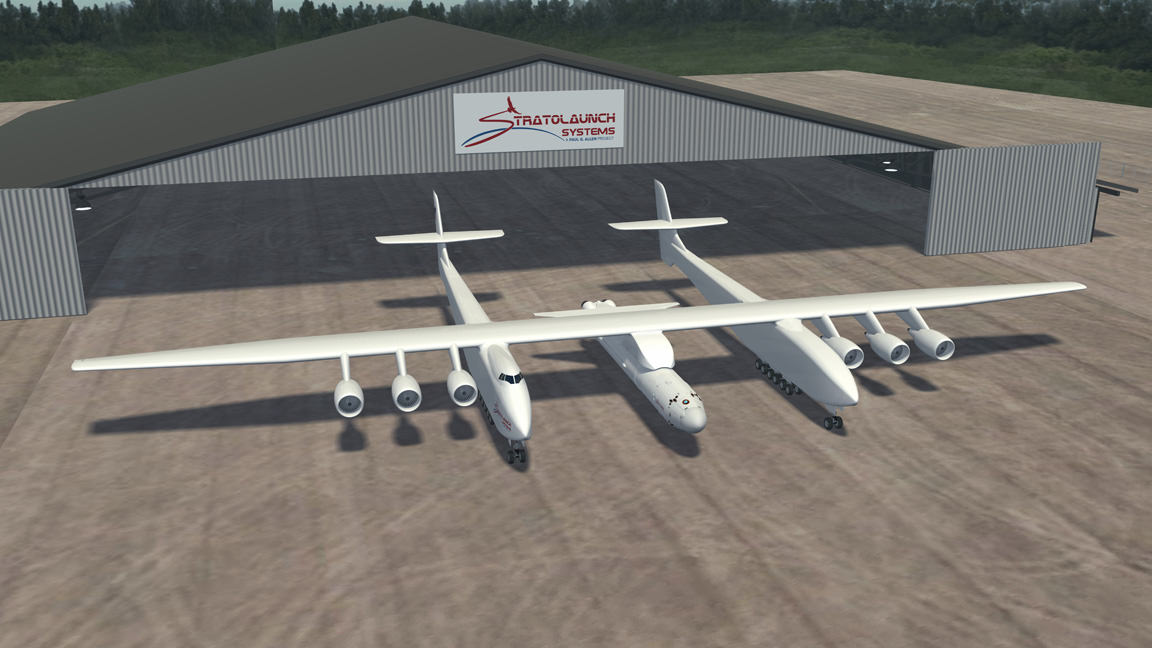
[/caption]
A mega quartet of luminaries led by Microsoft co-founder Paul G. Allen and legendary aerospace designer Burt Rutan have joined forces to create a revolutionary new approach to space travel. This new privately funded venture entails the development of a mammoth air-launched space transportation system that aims to dramatically cut the high costs and risks of launching both cargo and human crews to low Earth orbit.
Allen and Rutan are teaming up with Elon Musk, founder of Space Exploration Technologies Corp, or SpaceX, and Michael Griffin, former NASA Administrator, to build the world’s largest aircraft ever flown and use it as a platform to loft a multi-stage SpaceX rocket that will deliver a payload of some 13,500 pounds into earth orbit, about the same class as a Delta II.
Allen and Rutan hope to build upon the spaceflight revolution that they pioneered with the suborbital SpaceShipOne in 2004, which was the first privately funded spaceship to reach the edge of space, and now take the critical next step and actually vault all the way to orbit.
Video Caption: Stratolaunch Systems is pioneering innovative solutions to revolutionize space transportation to orbit.
To accomplish this innovative leap, Allen and Rutan, announced the formation of a new company, funded by Allen, called Stratolaunch Systems at a press briefing today, Dec. 13, held in Seattle, WA. Allen is a billionaire and philanthropist who has funded a host of projects to advance science,
“Our national aspirations for space exploration have been receding,” Allen lamented at the start of the briefing. “This year saw the end of NASA’s space shuttle program. Constellation, which would have taken us back to the moon, has been mothballed as well. For the first time since John Glenn, America cannot fly its own astronauts into space.”
“With government funded spaceflight diminishing, there’s a much expanded opportunity for privately funded efforts.”
Rutan said that Stratolaunch will build a 1.2 million pound carrier aircraft sporting a wingspan of 385 feet – longer than a football field – and which will be powered by six 747 engines on takeoff. The carrier will be a twin fuselage vehicle, like the WhiteKnight developed by Rutan to launch SpaceShipOne.

The 120 foot long SpaceX rocket, weighing up to 490,000 pounds, will be slung in between and dropped at an altitude of about 30,000 feet for the remaining ascent to orbit.
SpaceX will construct a shorter, less powerful version of the firms existing Falcon 9 rocket, which may be either a Falcon 4 or Falcon 5 depending on specifications.
The new launch system will operate from a large airport or spaceport like the Kennedy Space Center, require a 12,000 feet long runway for takeoff and landing and be capable of flying up to 1,300 nautical miles to the payload’s launch point. Crews aboard the huge carrier aircraft will also conduct the countdown and firing of the booster and will monitor payload blasting to orbit.
“I have long dreamed about taking the next big step in private space flight after the success of SpaceShipOne – to offer a flexible, orbital space delivery system,” Allen said. “We are at the dawn of radical change in the space launch industry. Stratolaunch Systems is pioneering an innovative solution that will revolutionize space travel.”
The goal of Stratolaunch is to “bring airport-like operations to the launch of commercial and government payloads and, eventually, human missions,” according to a company statement.
Plans call for a first orbital flight within five years by around 2016. Test flights could begin around 2015.
“We believe this technology has the potential to someday make spaceflight routine by removing many of the constraints associated with ground launched rockets,” said Mike Griffin. “Our system will also provide the flexibility to launch from a large variety of locations.”
Mike Griffin added that the venture is aiming for the small to medium class payload market similar to what has been served by the venerable Delta II rocket, which is now being retired after decades of service.
“NASA’s science satellites could also be lofted by Stratolaunch.”
“At some point this vehicle could loft a crew of say six people,” Griffin stated.
“This is an exciting day,” concluded Allen.
“Stratolaunch will keep America at the forefront of space exploration and give tomorrow’s children something to search for in the night sky and dream about. Work has already started on our project at the Mojave Spaceport.”
